Project Management Methodology Application Report - GU University
VerifiedAdded on 2022/09/16
|16
|3399
|17
Report
AI Summary
This report critically assesses various project management methodologies, including Waterfall, Agile, and Scrum, in the context of developing an online nursing simulation game for GU University's School of Nursing. The report begins with an introduction outlining the project's objectives, which involves creating a nursing simulation application for nurses to practice various skills. The discussion section provides detailed explanations of each methodology, highlighting their advantages and disadvantages. The Waterfall methodology, with its sequential approach, is contrasted with the Agile methodology, which emphasizes flexibility and iterative development. Scrum, a specific implementation of Agile, is also analyzed. The report then focuses on selecting the most appropriate methodology for the simulation game project, justifying the choice of Agile. The report concludes by summarizing the key findings and recommendations, emphasizing the importance of a well-suited project management methodology for successful project outcomes. References are included to support the analysis and recommendations.
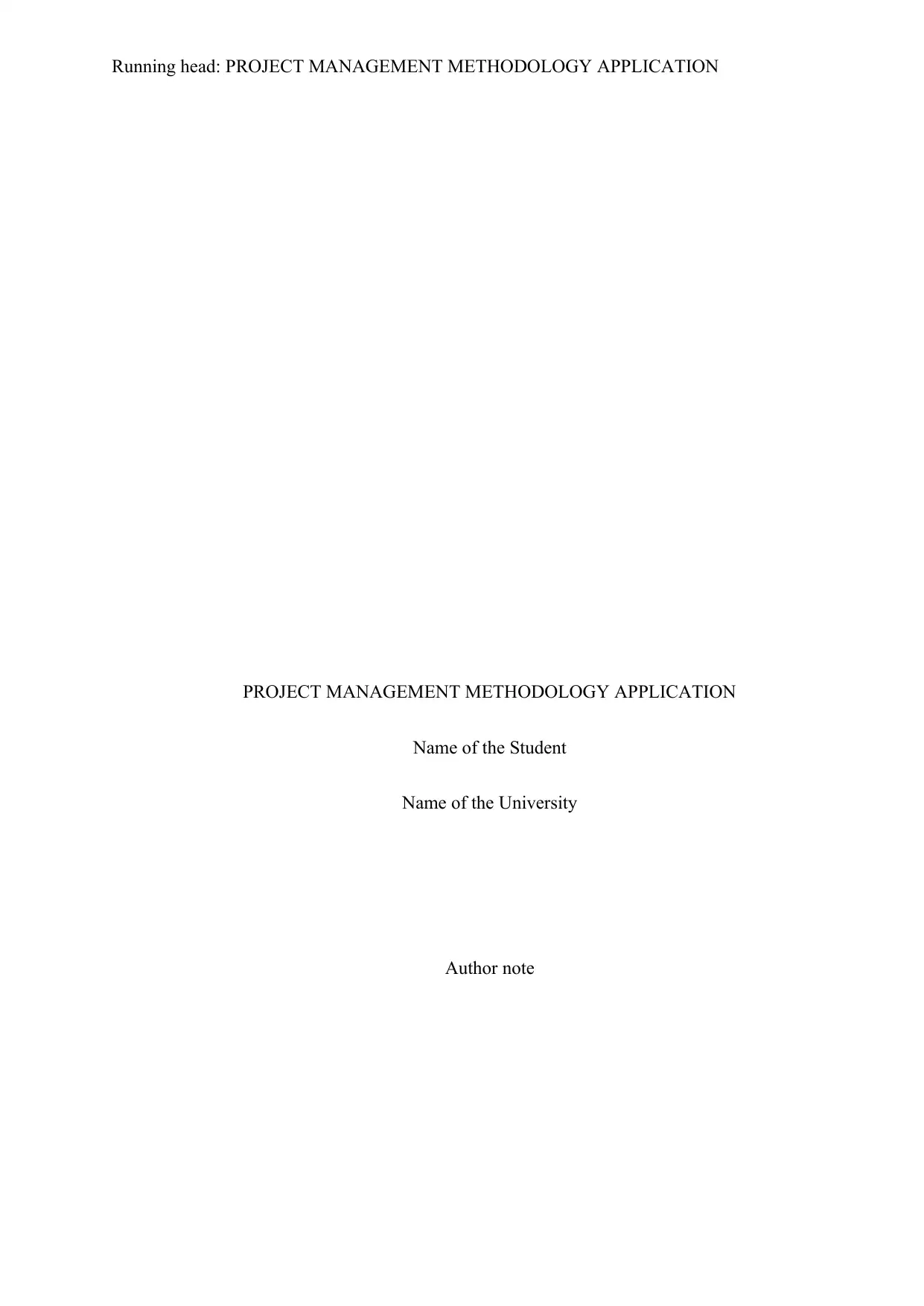
Running head: PROJECT MANAGEMENT METHODOLOGY APPLICATION
PROJECT MANAGEMENT METHODOLOGY APPLICATION
Name of the Student
Name of the University
Author note
PROJECT MANAGEMENT METHODOLOGY APPLICATION
Name of the Student
Name of the University
Author note
Paraphrase This Document
Need a fresh take? Get an instant paraphrase of this document with our AI Paraphraser
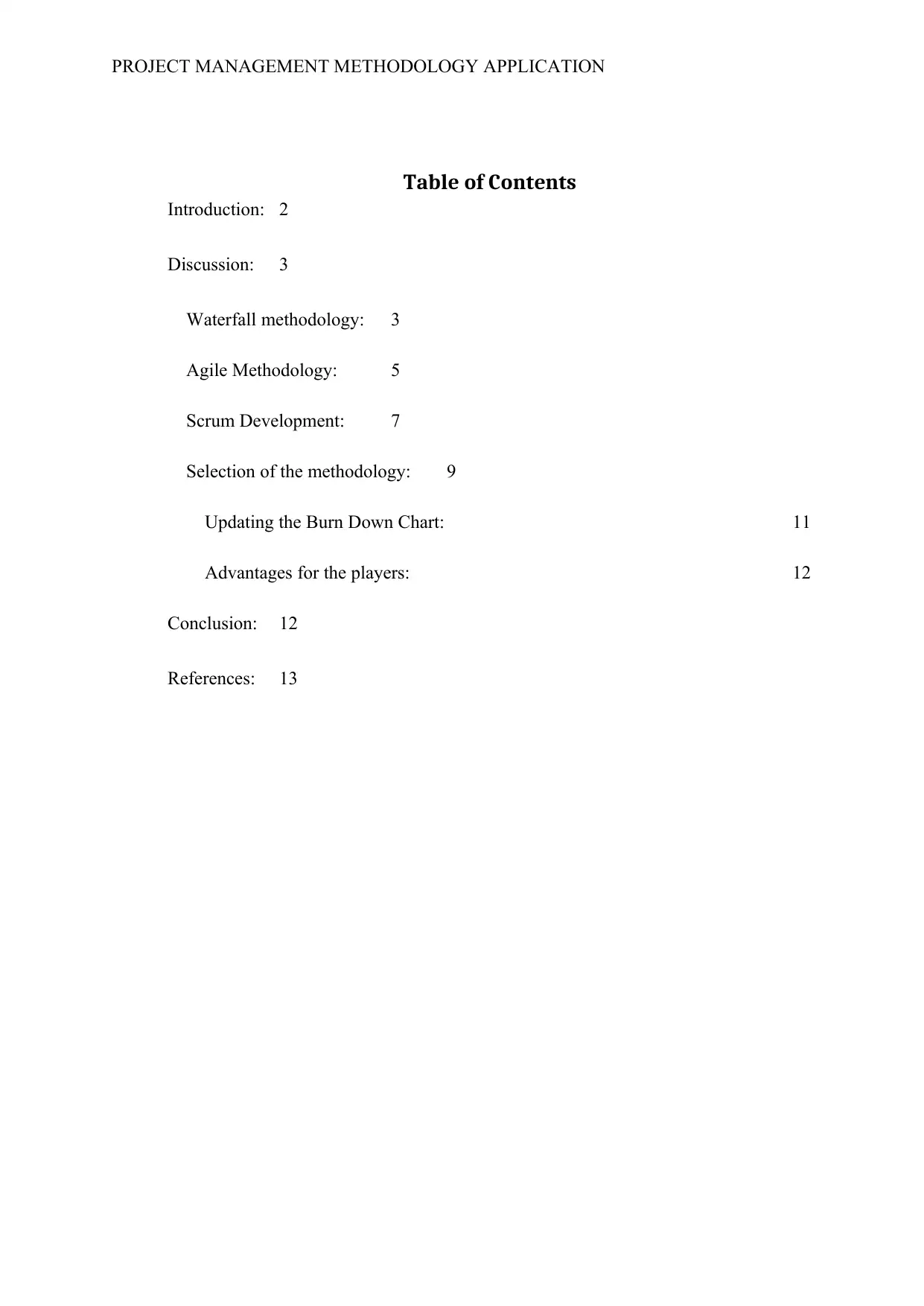
PROJECT MANAGEMENT METHODOLOGY APPLICATION
Table of Contents
Introduction: 2
Discussion: 3
Waterfall methodology: 3
Agile Methodology: 5
Scrum Development: 7
Selection of the methodology: 9
Updating the Burn Down Chart: 11
Advantages for the players: 12
Conclusion: 12
References: 13
Table of Contents
Introduction: 2
Discussion: 3
Waterfall methodology: 3
Agile Methodology: 5
Scrum Development: 7
Selection of the methodology: 9
Updating the Burn Down Chart: 11
Advantages for the players: 12
Conclusion: 12
References: 13

PROJECT MANAGEMENT METHODOLOGY APPLICATION
Introduction:
The aim of the report is to evaluate the different project management methodologies
where the role of the methodologies is to deliver successful outcomes for the project. In this
case study, The School of Nursing in GU University has taken the initiative to develop an
online simulating game for the school of nursing. The game is considered to be a nursing
simulation application where the nurses can practice administering medication, managing
intravenous lines, care for multiple patients, observations and recording patient’s conditions,
and communicate with doctors with, many more facilities. The developer has to consider
certain attributes for the project of the developing of the online simulation game like the
game will be interfaced for by teams of 3 nurses and 1 lecturer. The website that will be
developed will also posses creation features like the real time chat utility as well as
videoconferencing portal for collaboration. The team will require comprising security to
works for numerous users and offer online training for the project
A developer utilizes a project to attain objectives and scheduled outcomes in a
specified timetable and budget. Regardless of the sector or trade, there are a range of
methodologies to assist managers in each phase of the project from start to finish (Kerzner,
2017).
A methodology is a model used by project executives for their project objectives
design, plan, delivery and accomplishment (Špundak, 2014). There are distinct
methodologies for project leadership for various projects.
Introduction:
The aim of the report is to evaluate the different project management methodologies
where the role of the methodologies is to deliver successful outcomes for the project. In this
case study, The School of Nursing in GU University has taken the initiative to develop an
online simulating game for the school of nursing. The game is considered to be a nursing
simulation application where the nurses can practice administering medication, managing
intravenous lines, care for multiple patients, observations and recording patient’s conditions,
and communicate with doctors with, many more facilities. The developer has to consider
certain attributes for the project of the developing of the online simulation game like the
game will be interfaced for by teams of 3 nurses and 1 lecturer. The website that will be
developed will also posses creation features like the real time chat utility as well as
videoconferencing portal for collaboration. The team will require comprising security to
works for numerous users and offer online training for the project
A developer utilizes a project to attain objectives and scheduled outcomes in a
specified timetable and budget. Regardless of the sector or trade, there are a range of
methodologies to assist managers in each phase of the project from start to finish (Kerzner,
2017).
A methodology is a model used by project executives for their project objectives
design, plan, delivery and accomplishment (Špundak, 2014). There are distinct
methodologies for project leadership for various projects.
⊘ This is a preview!⊘
Do you want full access?
Subscribe today to unlock all pages.

Trusted by 1+ million students worldwide
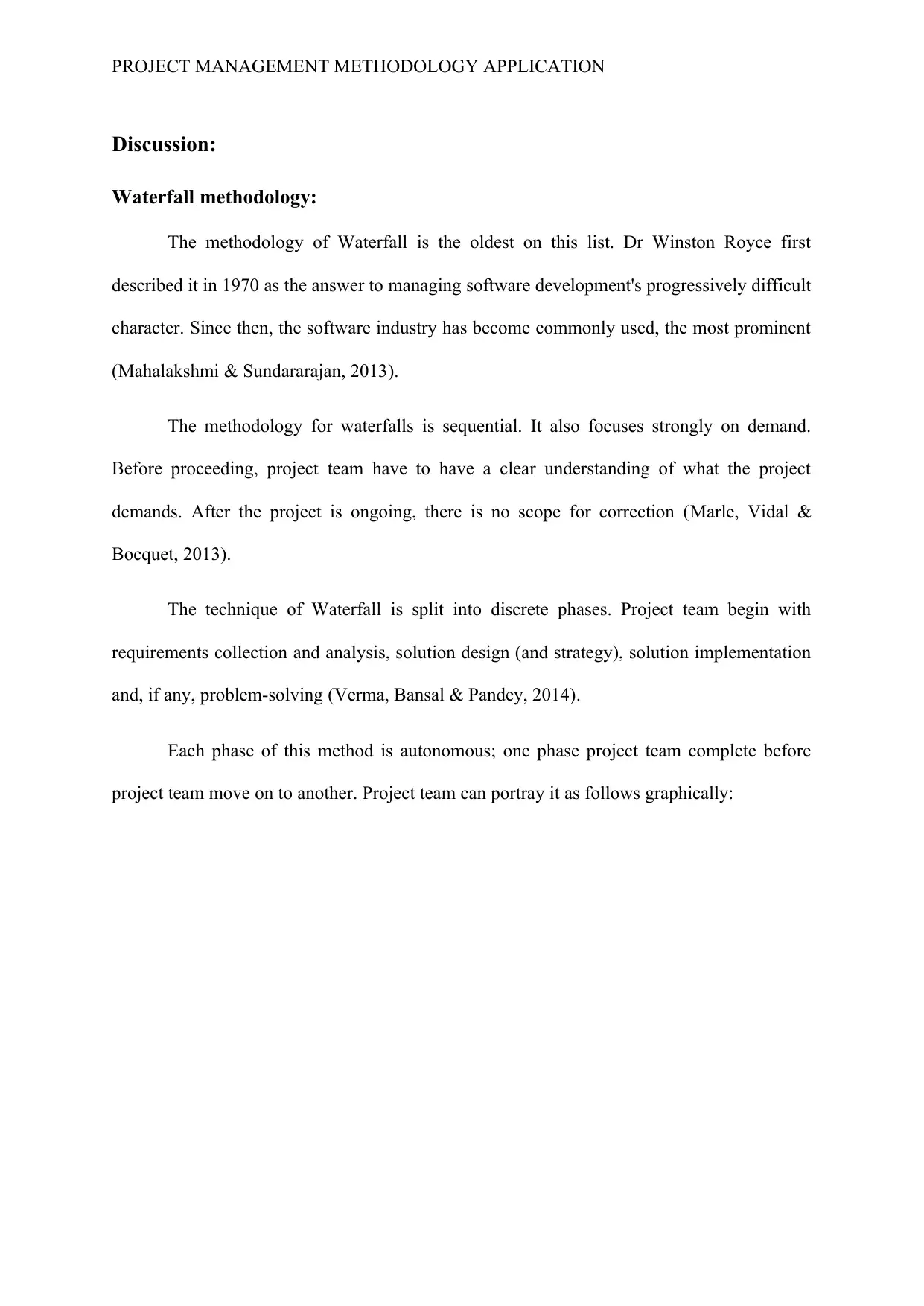
PROJECT MANAGEMENT METHODOLOGY APPLICATION
Discussion:
Waterfall methodology:
The methodology of Waterfall is the oldest on this list. Dr Winston Royce first
described it in 1970 as the answer to managing software development's progressively difficult
character. Since then, the software industry has become commonly used, the most prominent
(Mahalakshmi & Sundararajan, 2013).
The methodology for waterfalls is sequential. It also focuses strongly on demand.
Before proceeding, project team have to have a clear understanding of what the project
demands. After the project is ongoing, there is no scope for correction (Marle, Vidal &
Bocquet, 2013).
The technique of Waterfall is split into discrete phases. Project team begin with
requirements collection and analysis, solution design (and strategy), solution implementation
and, if any, problem-solving (Verma, Bansal & Pandey, 2014).
Each phase of this method is autonomous; one phase project team complete before
project team move on to another. Project team can portray it as follows graphically:
Discussion:
Waterfall methodology:
The methodology of Waterfall is the oldest on this list. Dr Winston Royce first
described it in 1970 as the answer to managing software development's progressively difficult
character. Since then, the software industry has become commonly used, the most prominent
(Mahalakshmi & Sundararajan, 2013).
The methodology for waterfalls is sequential. It also focuses strongly on demand.
Before proceeding, project team have to have a clear understanding of what the project
demands. After the project is ongoing, there is no scope for correction (Marle, Vidal &
Bocquet, 2013).
The technique of Waterfall is split into discrete phases. Project team begin with
requirements collection and analysis, solution design (and strategy), solution implementation
and, if any, problem-solving (Verma, Bansal & Pandey, 2014).
Each phase of this method is autonomous; one phase project team complete before
project team move on to another. Project team can portray it as follows graphically:
Paraphrase This Document
Need a fresh take? Get an instant paraphrase of this document with our AI Paraphraser

PROJECT MANAGEMENT METHODOLOGY APPLICATION
This is from the view of software creation. In creative project management, individual
phases would be distinct, but the strategy stays identical.
Advantages of the methodologies that can impact on the project are as follows:
One of its drivers is that managers guarantee design specifications and other
requirements by spending time in the early phases of a project, saving time
and effort usually in connection with retroactive correction of issues (Nicholas
& Steyn, 2017).
Easy to use: this model is understandable and easy to use. Regardless of
previous experience, the breakdown is intuitive and simple to understand.
Structure: The rigidity of the method of waterfall is a responsibility, but it can
also be strength. The clear distinction between phases contributes to the
organization and division of job. As it is not possible to return, at every point
project team need to be "ideal," which often results better (Calderón & Ruiz,
2015).
This is from the view of software creation. In creative project management, individual
phases would be distinct, but the strategy stays identical.
Advantages of the methodologies that can impact on the project are as follows:
One of its drivers is that managers guarantee design specifications and other
requirements by spending time in the early phases of a project, saving time
and effort usually in connection with retroactive correction of issues (Nicholas
& Steyn, 2017).
Easy to use: this model is understandable and easy to use. Regardless of
previous experience, the breakdown is intuitive and simple to understand.
Structure: The rigidity of the method of waterfall is a responsibility, but it can
also be strength. The clear distinction between phases contributes to the
organization and division of job. As it is not possible to return, at every point
project team need to be "ideal," which often results better (Calderón & Ruiz,
2015).

PROJECT MANAGEMENT METHODOLOGY APPLICATION
Documentation: The strong focus on demands for collecting and
comprehension makes the Waterfall model highly documented. This facilitates
the movement and work on the project of fresh funds, when necessary.
Disadvantages of the methodologies, or why it cannot be applied for the nursing
simulation project:
Higher risk: The rigidity of this approach implies that project team must
fundamentally begin the project from the beginning if project team discover an
mistake or have to modify anything. The risk of project failure is significantly
increased.
Front-heavy: The whole strategy to waterfall is highly based on project teamr
correct knowledge and analysis. Project team must begin again if project team
fail -or if the demands alter. This absence of flexibility makes it a difficult
decision for lengthy and complicated projects.
In software development, the Waterfall methodology is most often used. It operates
best for the following kinds of projects: short easy projects with clear and fixed needs
Projects with changed funds which rely on detailed paperwork.
Agile Methodology:
Agile, another software-oriented Project Management methodology was developed as
a reaction to Waterfall's inability to manage complicated projects. Although Agile PM ideas
were used for quite a while in the software industry, in 2001 several IT representatives issued
the "Agile Manifesto" It was officially formed (Mahalakshmi & Sundararajan, 2013).
Agile is the reverse of the technique of Waterfall in strategy and ideology. As the
name suggests, this technique supports the ability to approach quickly and flexibly (this is a
Documentation: The strong focus on demands for collecting and
comprehension makes the Waterfall model highly documented. This facilitates
the movement and work on the project of fresh funds, when necessary.
Disadvantages of the methodologies, or why it cannot be applied for the nursing
simulation project:
Higher risk: The rigidity of this approach implies that project team must
fundamentally begin the project from the beginning if project team discover an
mistake or have to modify anything. The risk of project failure is significantly
increased.
Front-heavy: The whole strategy to waterfall is highly based on project teamr
correct knowledge and analysis. Project team must begin again if project team
fail -or if the demands alter. This absence of flexibility makes it a difficult
decision for lengthy and complicated projects.
In software development, the Waterfall methodology is most often used. It operates
best for the following kinds of projects: short easy projects with clear and fixed needs
Projects with changed funds which rely on detailed paperwork.
Agile Methodology:
Agile, another software-oriented Project Management methodology was developed as
a reaction to Waterfall's inability to manage complicated projects. Although Agile PM ideas
were used for quite a while in the software industry, in 2001 several IT representatives issued
the "Agile Manifesto" It was officially formed (Mahalakshmi & Sundararajan, 2013).
Agile is the reverse of the technique of Waterfall in strategy and ideology. As the
name suggests, this technique supports the ability to approach quickly and flexibly (this is a
⊘ This is a preview!⊘
Do you want full access?
Subscribe today to unlock all pages.

Trusted by 1+ million students worldwide
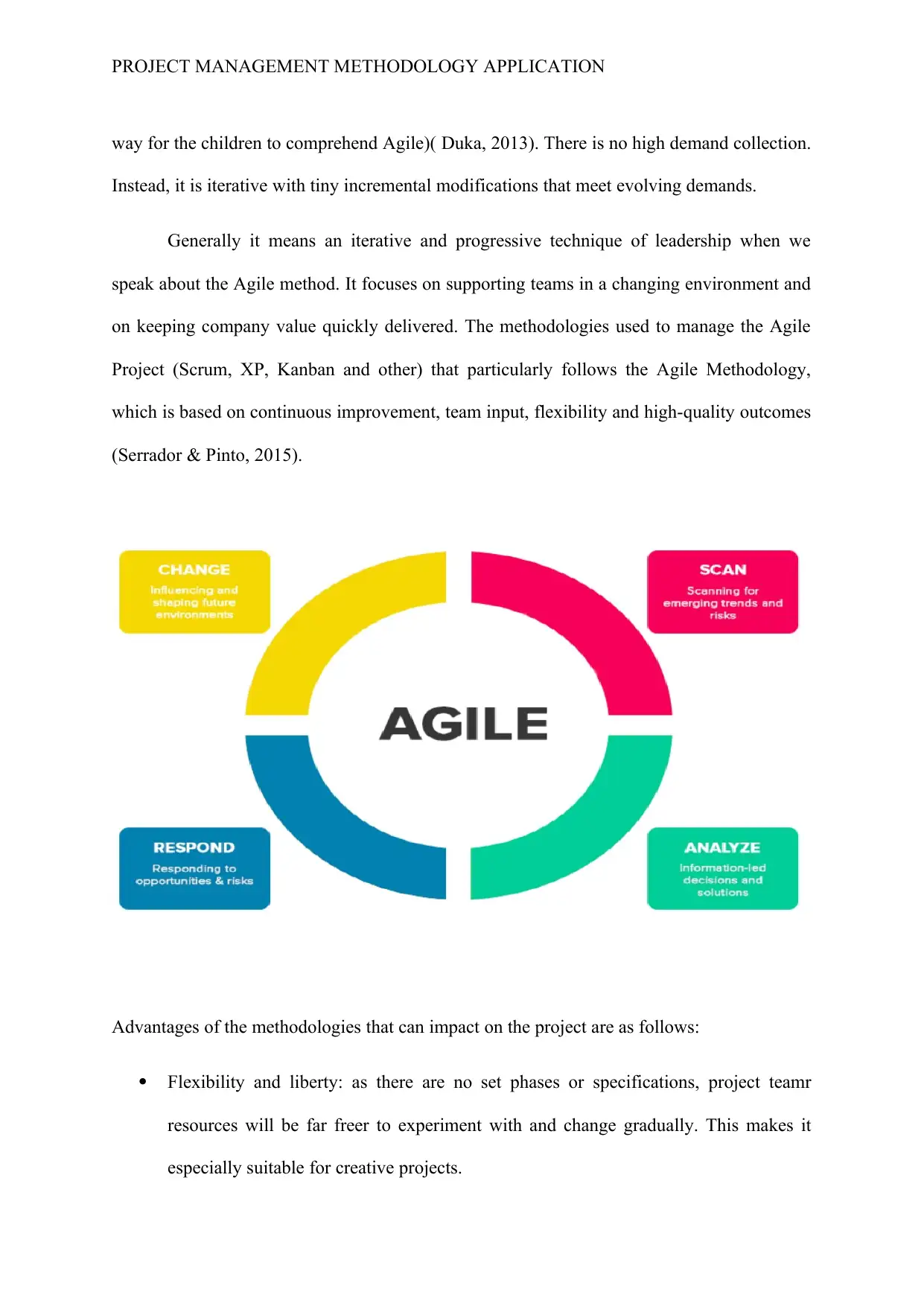
PROJECT MANAGEMENT METHODOLOGY APPLICATION
way for the children to comprehend Agile)( Duka, 2013). There is no high demand collection.
Instead, it is iterative with tiny incremental modifications that meet evolving demands.
Generally it means an iterative and progressive technique of leadership when we
speak about the Agile method. It focuses on supporting teams in a changing environment and
on keeping company value quickly delivered. The methodologies used to manage the Agile
Project (Scrum, XP, Kanban and other) that particularly follows the Agile Methodology,
which is based on continuous improvement, team input, flexibility and high-quality outcomes
(Serrador & Pinto, 2015).
Advantages of the methodologies that can impact on the project are as follows:
Flexibility and liberty: as there are no set phases or specifications, project teamr
resources will be far freer to experiment with and change gradually. This makes it
especially suitable for creative projects.
way for the children to comprehend Agile)( Duka, 2013). There is no high demand collection.
Instead, it is iterative with tiny incremental modifications that meet evolving demands.
Generally it means an iterative and progressive technique of leadership when we
speak about the Agile method. It focuses on supporting teams in a changing environment and
on keeping company value quickly delivered. The methodologies used to manage the Agile
Project (Scrum, XP, Kanban and other) that particularly follows the Agile Methodology,
which is based on continuous improvement, team input, flexibility and high-quality outcomes
(Serrador & Pinto, 2015).
Advantages of the methodologies that can impact on the project are as follows:
Flexibility and liberty: as there are no set phases or specifications, project teamr
resources will be far freer to experiment with and change gradually. This makes it
especially suitable for creative projects.
Paraphrase This Document
Need a fresh take? Get an instant paraphrase of this document with our AI Paraphraser
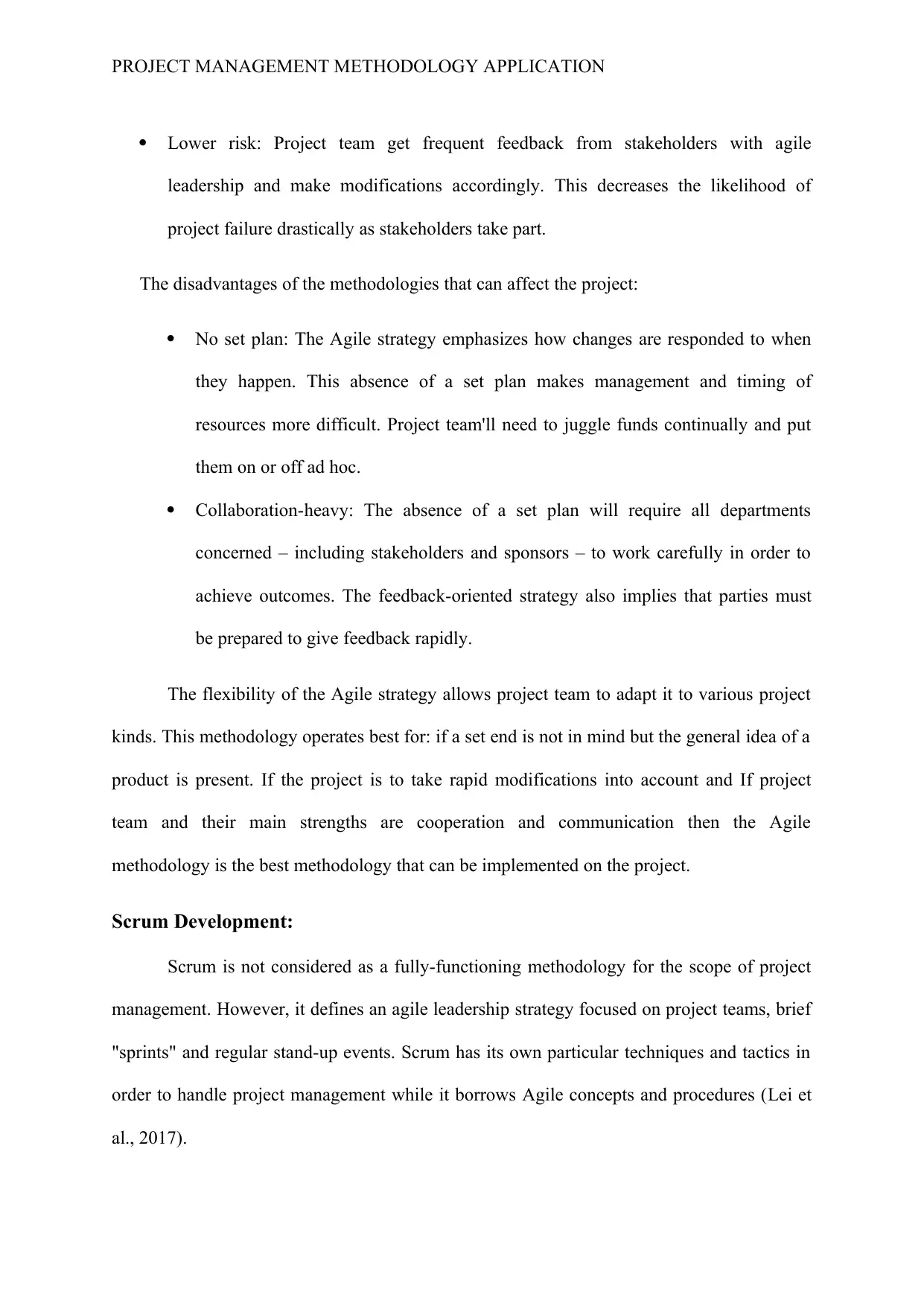
PROJECT MANAGEMENT METHODOLOGY APPLICATION
Lower risk: Project team get frequent feedback from stakeholders with agile
leadership and make modifications accordingly. This decreases the likelihood of
project failure drastically as stakeholders take part.
The disadvantages of the methodologies that can affect the project:
No set plan: The Agile strategy emphasizes how changes are responded to when
they happen. This absence of a set plan makes management and timing of
resources more difficult. Project team'll need to juggle funds continually and put
them on or off ad hoc.
Collaboration-heavy: The absence of a set plan will require all departments
concerned – including stakeholders and sponsors – to work carefully in order to
achieve outcomes. The feedback-oriented strategy also implies that parties must
be prepared to give feedback rapidly.
The flexibility of the Agile strategy allows project team to adapt it to various project
kinds. This methodology operates best for: if a set end is not in mind but the general idea of a
product is present. If the project is to take rapid modifications into account and If project
team and their main strengths are cooperation and communication then the Agile
methodology is the best methodology that can be implemented on the project.
Scrum Development:
Scrum is not considered as a fully-functioning methodology for the scope of project
management. However, it defines an agile leadership strategy focused on project teams, brief
"sprints" and regular stand-up events. Scrum has its own particular techniques and tactics in
order to handle project management while it borrows Agile concepts and procedures (Lei et
al., 2017).
Lower risk: Project team get frequent feedback from stakeholders with agile
leadership and make modifications accordingly. This decreases the likelihood of
project failure drastically as stakeholders take part.
The disadvantages of the methodologies that can affect the project:
No set plan: The Agile strategy emphasizes how changes are responded to when
they happen. This absence of a set plan makes management and timing of
resources more difficult. Project team'll need to juggle funds continually and put
them on or off ad hoc.
Collaboration-heavy: The absence of a set plan will require all departments
concerned – including stakeholders and sponsors – to work carefully in order to
achieve outcomes. The feedback-oriented strategy also implies that parties must
be prepared to give feedback rapidly.
The flexibility of the Agile strategy allows project team to adapt it to various project
kinds. This methodology operates best for: if a set end is not in mind but the general idea of a
product is present. If the project is to take rapid modifications into account and If project
team and their main strengths are cooperation and communication then the Agile
methodology is the best methodology that can be implemented on the project.
Scrum Development:
Scrum is not considered as a fully-functioning methodology for the scope of project
management. However, it defines an agile leadership strategy focused on project teams, brief
"sprints" and regular stand-up events. Scrum has its own particular techniques and tactics in
order to handle project management while it borrows Agile concepts and procedures (Lei et
al., 2017).
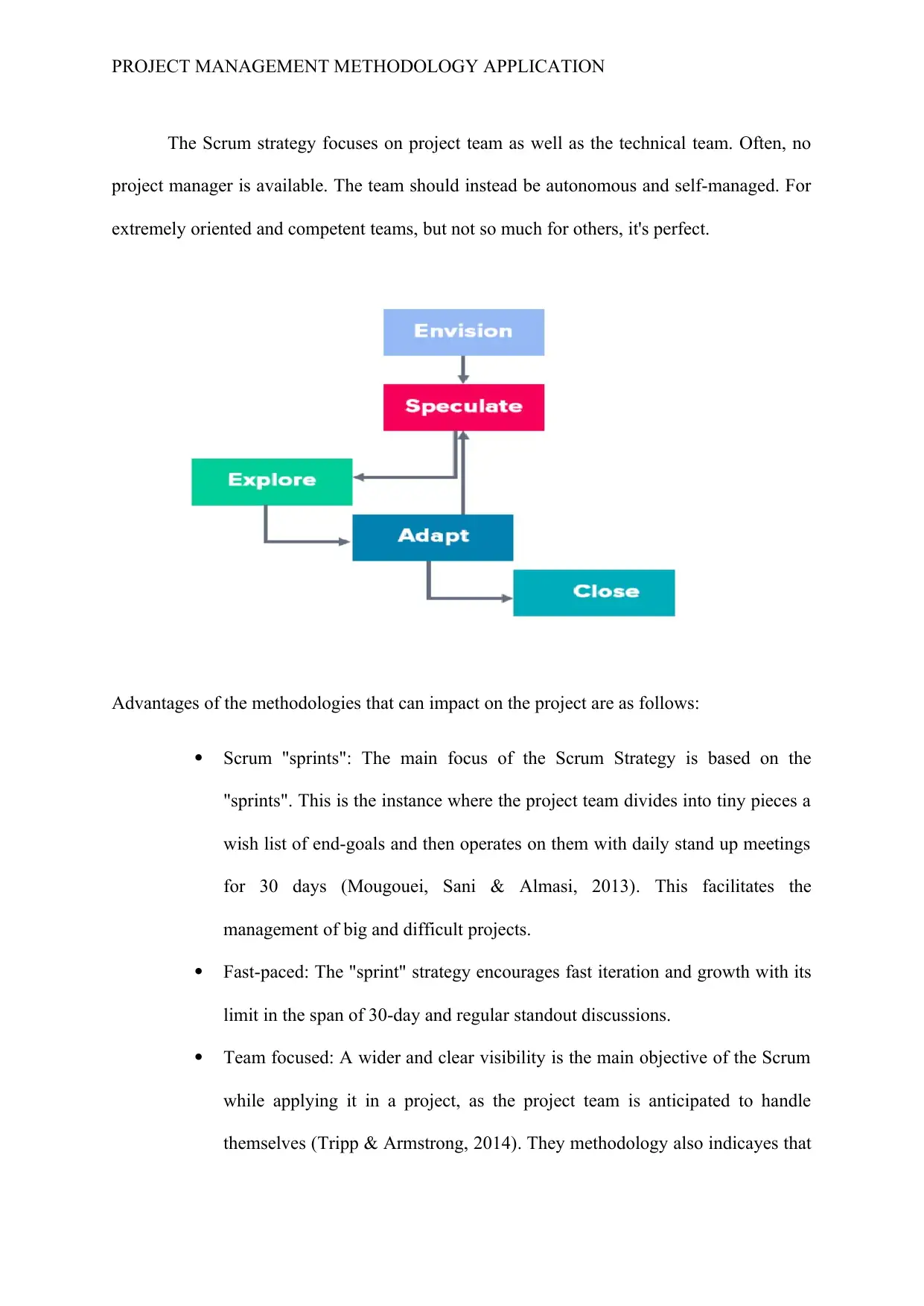
PROJECT MANAGEMENT METHODOLOGY APPLICATION
The Scrum strategy focuses on project team as well as the technical team. Often, no
project manager is available. The team should instead be autonomous and self-managed. For
extremely oriented and competent teams, but not so much for others, it's perfect.
Advantages of the methodologies that can impact on the project are as follows:
Scrum "sprints": The main focus of the Scrum Strategy is based on the
"sprints". This is the instance where the project team divides into tiny pieces a
wish list of end-goals and then operates on them with daily stand up meetings
for 30 days (Mougouei, Sani & Almasi, 2013). This facilitates the
management of big and difficult projects.
Fast-paced: The "sprint" strategy encourages fast iteration and growth with its
limit in the span of 30-day and regular standout discussions.
Team focused: A wider and clear visibility is the main objective of the Scrum
while applying it in a project, as the project team is anticipated to handle
themselves (Tripp & Armstrong, 2014). They methodology also indicayes that
The Scrum strategy focuses on project team as well as the technical team. Often, no
project manager is available. The team should instead be autonomous and self-managed. For
extremely oriented and competent teams, but not so much for others, it's perfect.
Advantages of the methodologies that can impact on the project are as follows:
Scrum "sprints": The main focus of the Scrum Strategy is based on the
"sprints". This is the instance where the project team divides into tiny pieces a
wish list of end-goals and then operates on them with daily stand up meetings
for 30 days (Mougouei, Sani & Almasi, 2013). This facilitates the
management of big and difficult projects.
Fast-paced: The "sprint" strategy encourages fast iteration and growth with its
limit in the span of 30-day and regular standout discussions.
Team focused: A wider and clear visibility is the main objective of the Scrum
while applying it in a project, as the project team is anticipated to handle
themselves (Tripp & Armstrong, 2014). They methodology also indicayes that
⊘ This is a preview!⊘
Do you want full access?
Subscribe today to unlock all pages.

Trusted by 1+ million students worldwide
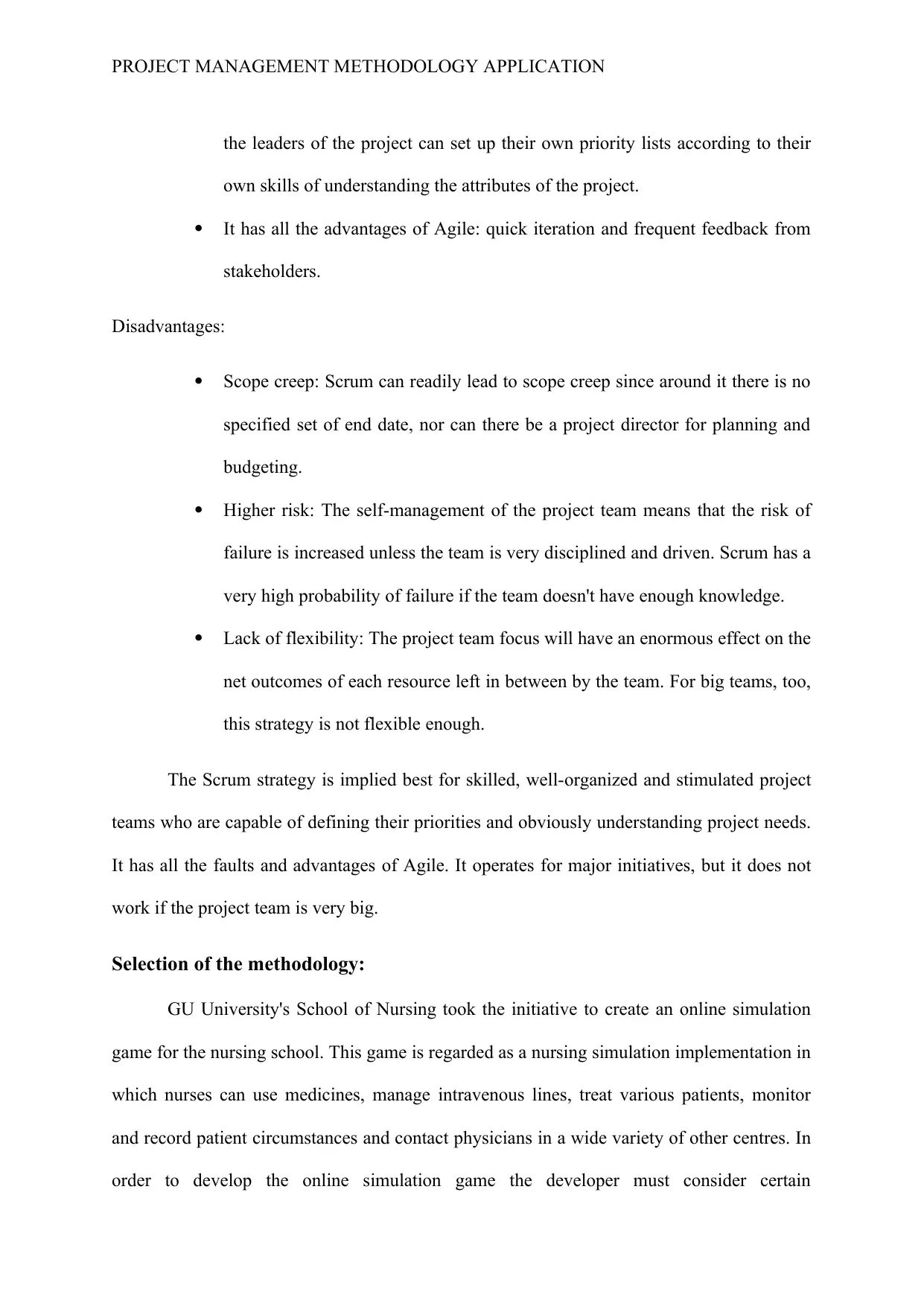
PROJECT MANAGEMENT METHODOLOGY APPLICATION
the leaders of the project can set up their own priority lists according to their
own skills of understanding the attributes of the project.
It has all the advantages of Agile: quick iteration and frequent feedback from
stakeholders.
Disadvantages:
Scope creep: Scrum can readily lead to scope creep since around it there is no
specified set of end date, nor can there be a project director for planning and
budgeting.
Higher risk: The self-management of the project team means that the risk of
failure is increased unless the team is very disciplined and driven. Scrum has a
very high probability of failure if the team doesn't have enough knowledge.
Lack of flexibility: The project team focus will have an enormous effect on the
net outcomes of each resource left in between by the team. For big teams, too,
this strategy is not flexible enough.
The Scrum strategy is implied best for skilled, well-organized and stimulated project
teams who are capable of defining their priorities and obviously understanding project needs.
It has all the faults and advantages of Agile. It operates for major initiatives, but it does not
work if the project team is very big.
Selection of the methodology:
GU University's School of Nursing took the initiative to create an online simulation
game for the nursing school. This game is regarded as a nursing simulation implementation in
which nurses can use medicines, manage intravenous lines, treat various patients, monitor
and record patient circumstances and contact physicians in a wide variety of other centres. In
order to develop the online simulation game the developer must consider certain
the leaders of the project can set up their own priority lists according to their
own skills of understanding the attributes of the project.
It has all the advantages of Agile: quick iteration and frequent feedback from
stakeholders.
Disadvantages:
Scope creep: Scrum can readily lead to scope creep since around it there is no
specified set of end date, nor can there be a project director for planning and
budgeting.
Higher risk: The self-management of the project team means that the risk of
failure is increased unless the team is very disciplined and driven. Scrum has a
very high probability of failure if the team doesn't have enough knowledge.
Lack of flexibility: The project team focus will have an enormous effect on the
net outcomes of each resource left in between by the team. For big teams, too,
this strategy is not flexible enough.
The Scrum strategy is implied best for skilled, well-organized and stimulated project
teams who are capable of defining their priorities and obviously understanding project needs.
It has all the faults and advantages of Agile. It operates for major initiatives, but it does not
work if the project team is very big.
Selection of the methodology:
GU University's School of Nursing took the initiative to create an online simulation
game for the nursing school. This game is regarded as a nursing simulation implementation in
which nurses can use medicines, manage intravenous lines, treat various patients, monitor
and record patient circumstances and contact physicians in a wide variety of other centres. In
order to develop the online simulation game the developer must consider certain
Paraphrase This Document
Need a fresh take? Get an instant paraphrase of this document with our AI Paraphraser
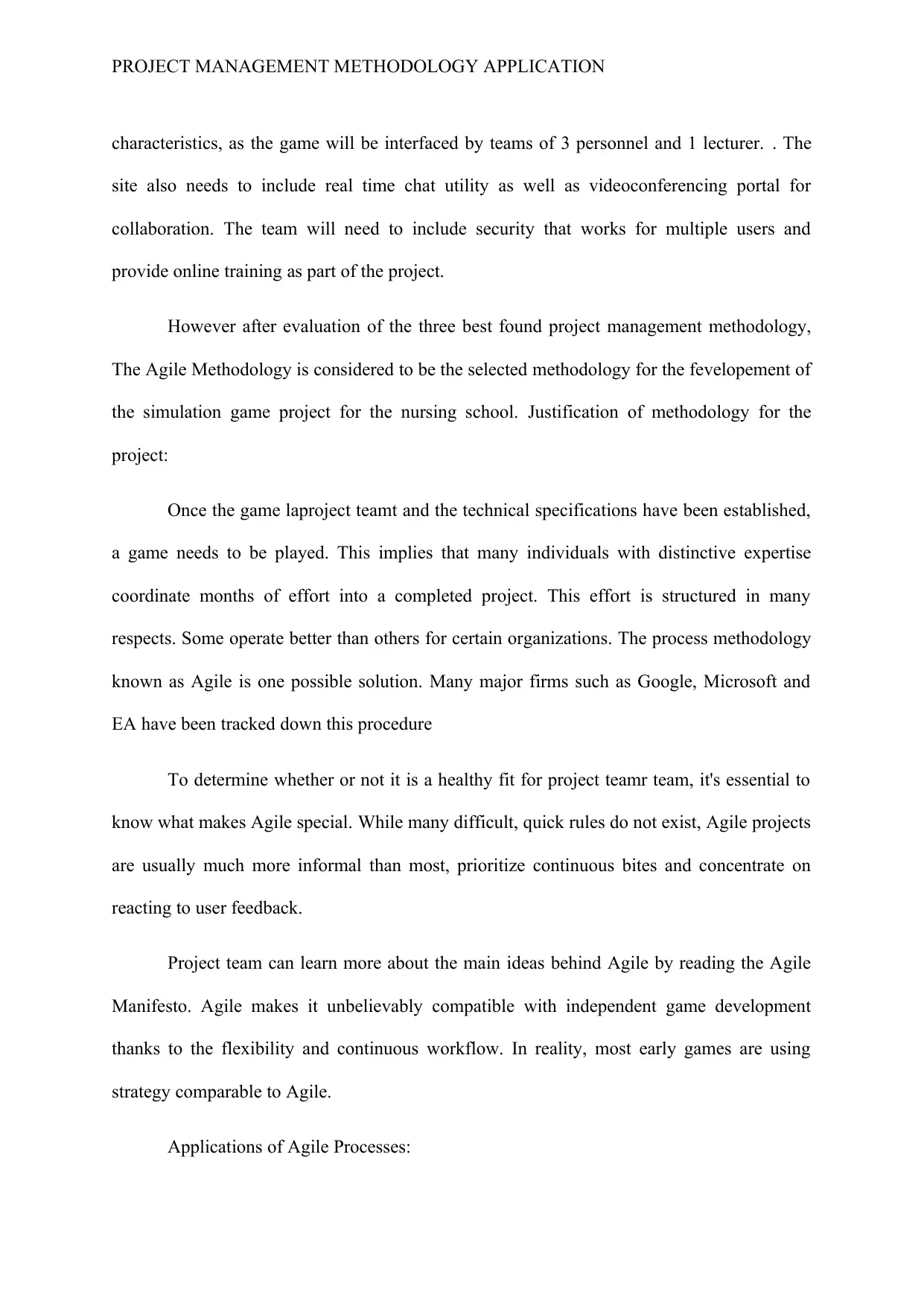
PROJECT MANAGEMENT METHODOLOGY APPLICATION
characteristics, as the game will be interfaced by teams of 3 personnel and 1 lecturer. . The
site also needs to include real time chat utility as well as videoconferencing portal for
collaboration. The team will need to include security that works for multiple users and
provide online training as part of the project.
However after evaluation of the three best found project management methodology,
The Agile Methodology is considered to be the selected methodology for the fevelopement of
the simulation game project for the nursing school. Justification of methodology for the
project:
Once the game laproject teamt and the technical specifications have been established,
a game needs to be played. This implies that many individuals with distinctive expertise
coordinate months of effort into a completed project. This effort is structured in many
respects. Some operate better than others for certain organizations. The process methodology
known as Agile is one possible solution. Many major firms such as Google, Microsoft and
EA have been tracked down this procedure
To determine whether or not it is a healthy fit for project teamr team, it's essential to
know what makes Agile special. While many difficult, quick rules do not exist, Agile projects
are usually much more informal than most, prioritize continuous bites and concentrate on
reacting to user feedback.
Project team can learn more about the main ideas behind Agile by reading the Agile
Manifesto. Agile makes it unbelievably compatible with independent game development
thanks to the flexibility and continuous workflow. In reality, most early games are using
strategy comparable to Agile.
Applications of Agile Processes:
characteristics, as the game will be interfaced by teams of 3 personnel and 1 lecturer. . The
site also needs to include real time chat utility as well as videoconferencing portal for
collaboration. The team will need to include security that works for multiple users and
provide online training as part of the project.
However after evaluation of the three best found project management methodology,
The Agile Methodology is considered to be the selected methodology for the fevelopement of
the simulation game project for the nursing school. Justification of methodology for the
project:
Once the game laproject teamt and the technical specifications have been established,
a game needs to be played. This implies that many individuals with distinctive expertise
coordinate months of effort into a completed project. This effort is structured in many
respects. Some operate better than others for certain organizations. The process methodology
known as Agile is one possible solution. Many major firms such as Google, Microsoft and
EA have been tracked down this procedure
To determine whether or not it is a healthy fit for project teamr team, it's essential to
know what makes Agile special. While many difficult, quick rules do not exist, Agile projects
are usually much more informal than most, prioritize continuous bites and concentrate on
reacting to user feedback.
Project team can learn more about the main ideas behind Agile by reading the Agile
Manifesto. Agile makes it unbelievably compatible with independent game development
thanks to the flexibility and continuous workflow. In reality, most early games are using
strategy comparable to Agile.
Applications of Agile Processes:
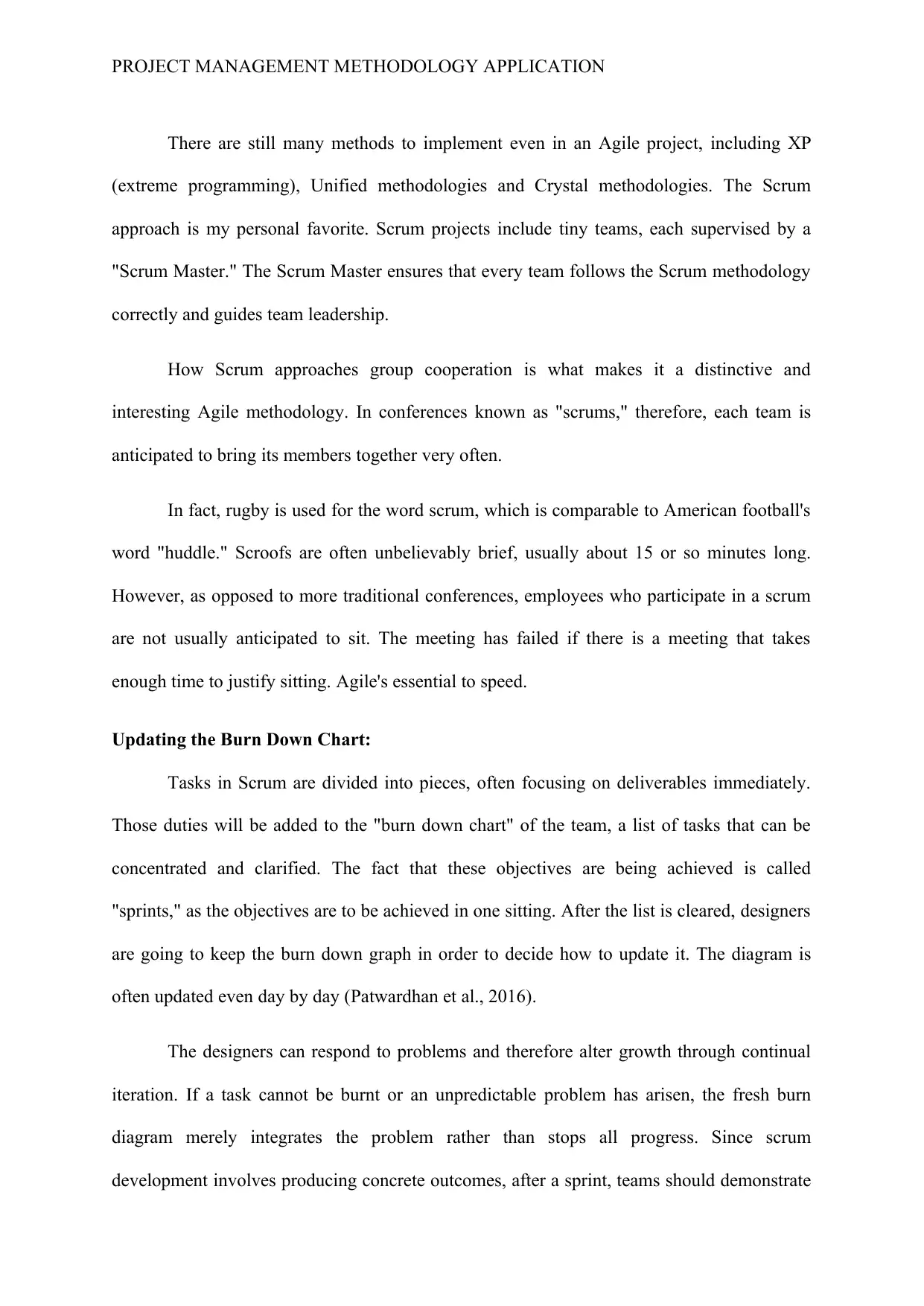
PROJECT MANAGEMENT METHODOLOGY APPLICATION
There are still many methods to implement even in an Agile project, including XP
(extreme programming), Unified methodologies and Crystal methodologies. The Scrum
approach is my personal favorite. Scrum projects include tiny teams, each supervised by a
"Scrum Master." The Scrum Master ensures that every team follows the Scrum methodology
correctly and guides team leadership.
How Scrum approaches group cooperation is what makes it a distinctive and
interesting Agile methodology. In conferences known as "scrums," therefore, each team is
anticipated to bring its members together very often.
In fact, rugby is used for the word scrum, which is comparable to American football's
word "huddle." Scroofs are often unbelievably brief, usually about 15 or so minutes long.
However, as opposed to more traditional conferences, employees who participate in a scrum
are not usually anticipated to sit. The meeting has failed if there is a meeting that takes
enough time to justify sitting. Agile's essential to speed.
Updating the Burn Down Chart:
Tasks in Scrum are divided into pieces, often focusing on deliverables immediately.
Those duties will be added to the "burn down chart" of the team, a list of tasks that can be
concentrated and clarified. The fact that these objectives are being achieved is called
"sprints," as the objectives are to be achieved in one sitting. After the list is cleared, designers
are going to keep the burn down graph in order to decide how to update it. The diagram is
often updated even day by day (Patwardhan et al., 2016).
The designers can respond to problems and therefore alter growth through continual
iteration. If a task cannot be burnt or an unpredictable problem has arisen, the fresh burn
diagram merely integrates the problem rather than stops all progress. Since scrum
development involves producing concrete outcomes, after a sprint, teams should demonstrate
There are still many methods to implement even in an Agile project, including XP
(extreme programming), Unified methodologies and Crystal methodologies. The Scrum
approach is my personal favorite. Scrum projects include tiny teams, each supervised by a
"Scrum Master." The Scrum Master ensures that every team follows the Scrum methodology
correctly and guides team leadership.
How Scrum approaches group cooperation is what makes it a distinctive and
interesting Agile methodology. In conferences known as "scrums," therefore, each team is
anticipated to bring its members together very often.
In fact, rugby is used for the word scrum, which is comparable to American football's
word "huddle." Scroofs are often unbelievably brief, usually about 15 or so minutes long.
However, as opposed to more traditional conferences, employees who participate in a scrum
are not usually anticipated to sit. The meeting has failed if there is a meeting that takes
enough time to justify sitting. Agile's essential to speed.
Updating the Burn Down Chart:
Tasks in Scrum are divided into pieces, often focusing on deliverables immediately.
Those duties will be added to the "burn down chart" of the team, a list of tasks that can be
concentrated and clarified. The fact that these objectives are being achieved is called
"sprints," as the objectives are to be achieved in one sitting. After the list is cleared, designers
are going to keep the burn down graph in order to decide how to update it. The diagram is
often updated even day by day (Patwardhan et al., 2016).
The designers can respond to problems and therefore alter growth through continual
iteration. If a task cannot be burnt or an unpredictable problem has arisen, the fresh burn
diagram merely integrates the problem rather than stops all progress. Since scrum
development involves producing concrete outcomes, after a sprint, teams should demonstrate
⊘ This is a preview!⊘
Do you want full access?
Subscribe today to unlock all pages.

Trusted by 1+ million students worldwide
1 out of 16
Related Documents
Your All-in-One AI-Powered Toolkit for Academic Success.
+13062052269
info@desklib.com
Available 24*7 on WhatsApp / Email
![[object Object]](/_next/static/media/star-bottom.7253800d.svg)
Unlock your academic potential
Copyright © 2020–2025 A2Z Services. All Rights Reserved. Developed and managed by ZUCOL.





